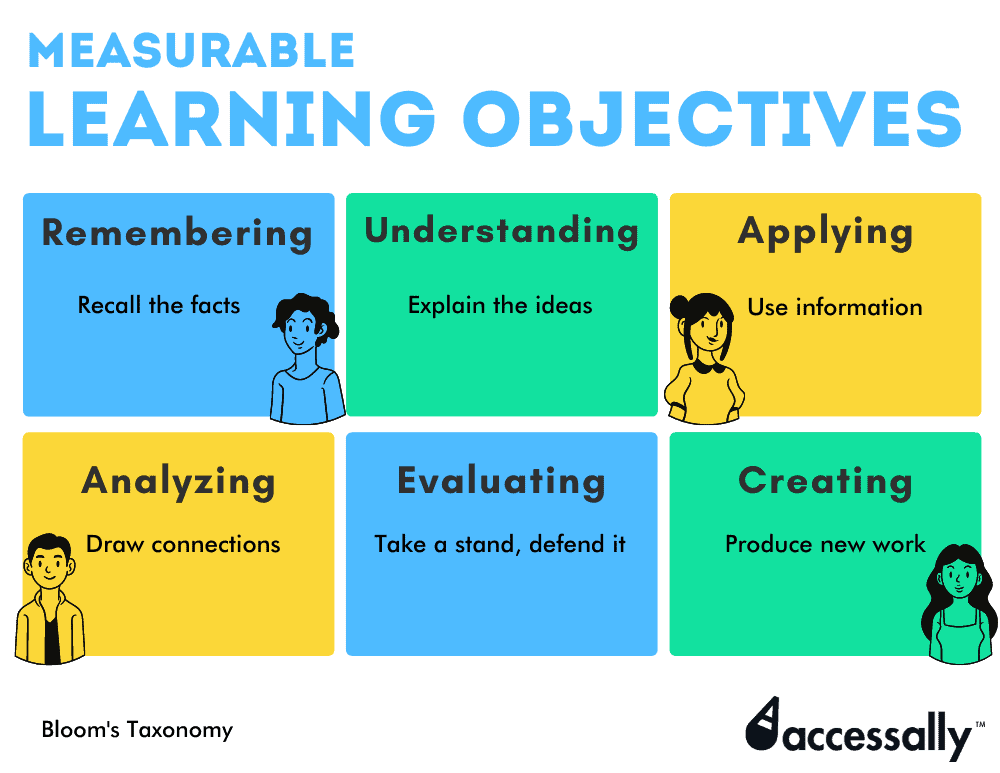Whether you’re working on creating your first course or you need to teach something you’ve taught before, it’s important to be able to articulate what the learning objectives are.
First, let’s get clear on what the goal of setting learning objectives is.
Learning objectives are designed to help your students achieve an appropriate level of understanding or mastery within a learning unit or course.
Learning objectives are not about the teachers, although they are extremely useful to guide your teaching toward measurable outcomes.
What are learning objectives and how can I write them?
A learning objective is a short statement that tells students what they will be able to accomplish after they have completed a course or lesson.
A course curriculum or a list of topics covered in an outline is too broad. Instead, each lesson should have one or more measurable learning objectives. These learning objectives tie back into the goal of the course itself.
For example: by the end of this online course, you will be able to read music and play the notes you read.
But before you rush into writing objectives, it’s important to know how each learning objective ties into the promises of your course.
You might be wondering how do I write my learning goals to benefit student learning? Let’s dive into that.
Writing Measurable Learning Objectives
The best learning objective is one that uses an action verb, and that includes measurable objectives.
Although it might feel easier to state broad foundational knowledge that a student should have by the end of a course, your learning objectives will be more effective if they are specific.
In fact, based on the learning level of the student, a learning objective that includes a learning activity is one of the most beneficial for students. That’s because learning skills happens in the process of doing a task or activity.
That way, you can have an assessment that lines up with the training at hand, and that shows measurable outcomes for the students.
Using Action Verbs for Clear learning objectives
Let’s start with action verbs and some measurable learning objectives examples:
- By the end of this course, you will be able to use a hand saw to construct woodworking projects.
- By the end of this course, you will know how to create a wireframe prototype for a website project.
- By the end of this course, you will be able to apply Bloom’s taxonomy in your own online courses.
When writing learning objectives, it’s important to keep it to the skills that students will be able to perform. You don’t want to make your learning objective the course project or assignment you plan to require.
By choosing a measurable verb, you can give your objectives a leg up. You don’t need to rely on knowledge alone to describe how you want students to demonstrate their new level of learning.
Instead, try some of these action verbs that come from the cognitive domain and Bloom’s taxonomy (more on that in the next section):
- Name, Recall, Recognize, Define, Describe
- Demonstrate, Explain, Interpret, Summarize, Show
- Organize, Produce, Solve, Classify, Prepare
- Compare, Identify, Combine, Outline, Illustrate
- Judge, Assess, Contrast, Rate, Support, Measure
- Design, Develop, Make, Invent, Construct, Formulate, Compose, Generate
Using Bloom’s Taxonomy to Write Effective Learning Objectives
In 1956, a group of researchers came up with a framework to help better define teaching objectives based on the level of mastery of students.
Bloom taxonomies are grouped into various categories based on learning objectives.


In a nutshell, the revised version of Bloom’s Taxonomy looks like this:
- Remember: this type of learning objective is the simplest and only requires students to recall facts and concepts
- Understand: this asks a student to demonstrate deeper knowledge, by being able to explain ideas and assess concepts at a deeper level
- Apply: being able to use knowledge in new situations and change their behavior based on information or demonstrate their know-how
- Analyze: this process shows cognitive support toward comparing and drawing connections between ideas, and organizing knowledge
- Evaluate: the focus here is on being able to identify a position and argue or defend it, for example when making a stand or taking a decision
- Create: this is the highest level of skill and involves the mastery to create or construct something through to completion
For example, you might identify that the first module of your course should focus on outcomes in the “understanding” category.
Then as students move through the process to complete your course, they should be able to write, analyze, and create with the ideas and concepts from your course.
You might then have an assessment or evaluation to measure the success of your teaching.
Bloom’s Taxonomy as a Framework for Writing Learning Objectives
Now that you how Bloom’s taxonomy can help you when creating measurable learning objectives, it’s time to it all together.
Start with your overarching course objective, and brainstorm the skills, and education you are trying to impart in your course.
Planning each lesson to incorporate a component or skill that is measurable and easy to develop one after another.
Then describe the outcomes or behavior that a student can expect, so they can relate to the words you use.
Do a final pass over your learning objective list and make sure there is an action verb for each objective.
Writing learning objectives might seem a bit tedious, but it can help differentiate your course from all of the other ways someone can learn these days.
Sharing learning objectives with students
Learning objectives shape student learning.
How you share your measurable learning objectives with students is a big part of their success. You can’t just give them a long list of skills or knowledge they are supposed to have by the end of the course.
That’s overwhelming and will not lead to enthusiastic behavior on the part of students.
Instead, you want to add specific objectives to the lesson pages of your online course themselves.
That’s where writing objectives that students can relate to is so important.
You can use a learning management system plugin like AccessAlly, which lets you add an objective table to each page.
These objectives can then be checked off by learners themselves, or you can have an evaluation step like a quiz or other measure of success like a private note.
Educators of all types are finding that spending a bit more time coming up with lesson objective ideas that describe the ideal outcome for students can go a long way to helping them succeed.
Examples of learning objectives
Let’s take a look at a few example screenshots that show different completion criteria for a course:


Tips for writing effective learning objectives
So far you have learned how to describe the outcome a student can expect from each lesson and your course as a whole.
Writing an objective should become second nature to you, and soon you will be able to measure the effectiveness of your efforts.
Remember to differentiate between the different levels of mastery you are aiming for: cognitive domain, affective, or emotional.
Not every student will appreciate the degree to which you expect them to succeed. But by giving yourself time to test and evaluate your objectives, and makes tweaks to any assessment, you’ll be well on your way to a course that gets great results for everyone who takes it.


